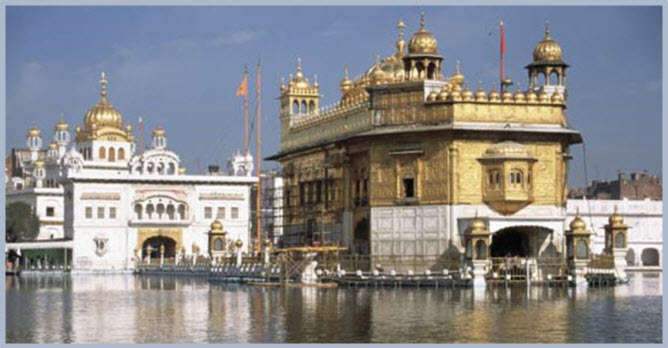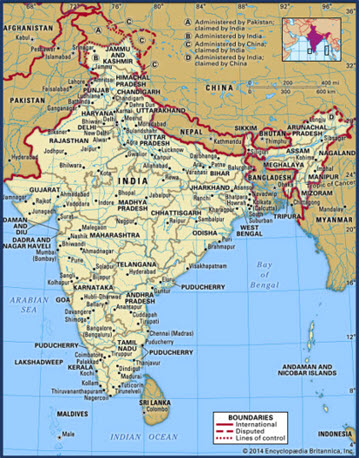The Decolonization of India
Unit Overview
Following World War II, the British crown granted full independence to the Hindu and Muslim populations of India. Although both groups anticipated this action, conflicts developed over the guiding principles of the new state. The Muslims won their bid for a separation from India with its Hindu majority and formed two countries, Pakistan and Bangladesh. This did not, however, resolve the problems among Muslims, Hindus and other religious sects. Let’s see how it all happened.
|
 |
|
| |
Complete the video below.
|
|
|
| |
Section A Questions
Use the information from the video to answer the following questions:
|
|
|
| |
| 1) Which of the following was an Indian revolutionary who led his country in the fight for freedom from British rule: |
|
|
| Correct! |
|
| |
|
| |
|
| |
|
| |
|
Section B Questions
Use the information found in Pressure for Independence to answer the following questions:
|
|
|
| |
| 5) Which of the following was not true of the Indian National Congress Party: |
|
|
| Correct! |
|
| |
|
| 6) The Salt Laws made it illegal for Indians to do all but which of the following: |
|
|
| Correct! |
|
| |
|
| 7) About how many Indian protesters were jailed as a result of their involvement in the Salt March? |
|
|
| Correct! |
|
| |
|
| 8) After newspaper accounts of the protests in India were published around the world, the British granted Indians some self-government but not full independence. |
|
|
| Correct! |
|
| |
|
| 9) What were the two main goals of the Muslim League? |
|
3849 character(s) left
Your answer is too long. |
| Correct! |
|
| |
|
| 10) How did Mahatma Gandhi and his followers believe that a separate Muslim state would affect the relationship between Hindus and Muslims? |
|
|
| Correct! |
|
| |
|
| 11) The partition of India was a direct result of which of the following: |
|
|
| Correct! |
|
| |
|
Section C Questions
Use the information found in Pakistan and Bangladesh to answer the following questions:
|
 |
|
| |
| |
|
| 13) East Pakistan and West Pakistan differed in all but which of the following: |
|
|
| Incorrect |
|
| |
|
| 14) Following the division of India and Pakistan, population and political power was equally divided between East Pakistan and West Pakistan. |
|
|
| Correct! |
|
| |
|
| 15) Which of the following was not true of Bangladesh: |
|
|
| Correct! |
|
| |
|
Section D Questions
Use the information in India's Political and Religious Divisions to answer the following questions:
|
|
|
| |
| 16) List three religious groups other than Muslims and Hindus that were present in India. |
|
3967 character(s) left
Your answer is too long. |
| Correct! |
|
| |
|
| |
|
| 18) India's government used the federal system to cope with which of the following: |
|
|
| Incorrect |
|
| |
|
| 19) Members of the Congress Party backed Indira Gandhi for prime minister because they believed that she would be easy to control. |
|
|
| Incorrect |
|
| |
|
| 20) India's relationship with Pakistan improved under Indira Gandhi's leadership. |
|
|
| Correct! |
|
| |
|
| 21) Which of the following best defines the reason for the occupation of the Golden Temple in Punjab: |
|
|
| Correct! |
|
| |
|
| 22) The attempt by India’s Congress Party to separate government and religion is similar to which of the following principles of American government: |
|
|
| Incorrect |
|
| |
|
| 23) By 2001, both Pakistan and India had engaged in a military escalation and had tested nuclear weapons |
|
|
| Correct! |
|
| |
|
| 24) The Sri Lankans were traditionally which of the following in respect to religion: |
|
|
| Correct! |
|
| |
|
| 25) How did the Indian government respond to the uprising led by the Liberation Tigers of Tamil Eelam? |
|
3922 character(s) left
Your answer is too long. |
| Correct! |
|
| |
|
Section E Questions
Use the information in The Challenge of an Increasing Population to answer the following questions:
|
 |
|
| |
| 26) India's growing population has made it difficult to improve which of the following: |
|
|
| Correct! |
|
| |
|
| 27) Which of the following is true concerning India's agricultural output: |
|
|
| Incorrect |
|
| |
|
| 28) Dependence on which of the following imports is the most harmful to the Indian economy: |
|
|
| Correct! |
|
| |
|
| 29) Which of the following would be the most likely to oppose mandatory sterilization as way to resolve the issues created by India's increasing population: |
|
|
| Correct! |
|
| |
|
30) Choose one of the following activities below and complete a time log.
1. Gandhi's Philosophy Poster
Create a poster that highlights Mahatma Gandhi's philosophy of nonviolence and civil disobedience.
Include key quotes from Gandhi, a brief description of his principles, and how they were applied during the Salt March.
Use drawings or symbols that represent peace and unity.
2. Cause and Effect Chart
Create a cause-and effect chart that outlines major events leading to Indian independence (e.g., the Salt March, the formation of the Muslim League, partition of India).
For each event, list one cause and one effect.
Use 1-2 sentences for each cause and effect. |
|
| No offline activities found |
0 Hour(s) & 0 Minute(s)
|
| Not Graded |
|
|
Attachments |
|